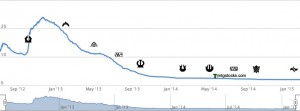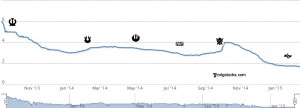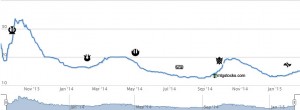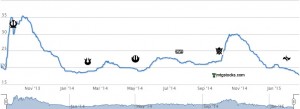Are you a Quiet Speculation member?
If not, now is a perfect time to join up! Our powerful tools, breaking-news analysis, and exclusive Discord channel will make sure you stay up to date and ahead of the curve.
I say sell it all. It's time to think about cashing in your chips and placing your bets elsewhere, there's simply no more money to be made off these cards. The longer you hold onto em, the more you're bound to lose.
I am, of course, referring to those Theros block staples you've been sitting on for the last year (note: I'm lumping M15 in with Theros, as they rotate together). With the lack of clearly defined PTQ seasons, rotation is not as clear as it used to be, but the writing is already on the wall and understanding the halflife of Standard prices is critical for maintaining your collection's value as a player.
As a general rule, your cards are always going to be worth the most money when you are most likely to need them... and there's a reason for that. Cards that appear in popular and successful decks tend to hold their price because people need them to win, and I'm guessing that you're probably trying to win once in a while.
For the bulk of Standard cards, rotation means a financial flatline. Even Standard staple all stars aren't immune to this effect.
The pricing graph for Thragtusk pretty much sums up everything you need to know about price trends for Standard cards.
First: the price peaks right after the rotation, in this case that would have been as Scars of Mirrodin block left the format. The price always peaks at this time because it's likely that the new set will hog the spotlight and the older sets just won't be opened, and there is usually a fundamental shift in the metagame at this time.
New metagame means new decks leading the format and players are left often left scrambling to acquire the best deck in a short amount of time forcing demand (and subsequently price) to spike before tapering off.
Second: It's pretty much all downhill from there. For many players, acquiring the most powerful cards is a means to an end. That end is (was) usually Pro Tour invites or large cash prizes. In the past, we had clearly defined PTQ seasons and needed those cards until our last tournament of the season.
With the PPTQ system, however, there is likely going to be a more gradual sell off as rotation becomes imminent. But, regardless of the rotation trends, there are very few examples of a card spiking after the October/November set release and metagame shift.
It's Time to Sell
Now's the time to take stock of your play style and your play needs for the next 8 months.
While you can hold on to your playsets of Temples and Painlands, it's likely you know what colors you're not going to have any interest in playing between now and August. If you're strongly in the U/B Control camp, hold onto your Temple of Deceit, but ship everything else. If you see yourself playing Abzan or Sultai down to the wire, keep those Temple of Malady and Llanowar Wastes but consider shipping your Temple of Triumph, Temple of Epiphany, and Temple of Enlightenment.
While you're probably going to get stuck holding a few losers from Theros, knowing your personal taste and play style will help you avoid being stuck holding the whole lot.
The other thing to keep in mind: if you're waiting for the prices to peak, you've already missed it and now you're solely in the business of damage control.
Short Selling
Those of you that are familiar with stock markets understand the concept of short sales.
For those that don't - you're betting that a stock is going to go down in price so you borrow a number of shares to sell now with the promise of replacing them at a future date. If you sell a stock for $10 a share today and then rebuy it for $8 a share when it's time to return those shares, you've netted $2 a share in profits.
You can perform a similar function with Magic through trading, and, to a lesser effect, selling.
For example: going into Khans of Tarkir there were many indications that the Onslaught fetchlands were going to be reprinted. I knew that in the long term picture that I was going to need these cards to play Legacy but had no tournaments in the short term so I shipped nearly all of my Onslaught fetches with the intent to rebuy after release at a reduced price.
Convenience Fee
The other factor to take into account at rotation is how much you value your time. I know that Mana Confluence is going to take a hit at rotation, but is the difference between it's price now and it's price in eight months going to be worth the effort of shipping and reacquiring these cards?
If you're the type to move most of your cards to vendors and buylists for cash, the answer is probably not. If you're an active trader at tournaments or through services like Pucatrade, you can store that value in better investments without paying a percentage to the house.
Personally, I probably won't bother with my Mana Confluences because I picked them up at their lowest price and don't think the price will shift dramatically enough to warrant the hassle.
But what cards are sure sells at this point?
The Temples are done for. These cards have made little to no splash in Modern and certainly won't see any play in Legacy. There is no "up" for these cards any more, and the floor is basically bulk. While they'll probably remain popular in Commander and casual formats for a long time, the supply in circulation is utterly massive.
Remember the pricing on the Painlands before they were Standard legal again? I'll give you a hint: $2 was generous.
Just look at Temple of Abandon. That graph has a pretty clear trajectory and holding holding onto a playset of these will cost you $8 at rotation, and this is likely the least painful of the Temples.
Now look at that price tag--a playset of Temple of Malady is currently worth more than the ENTIRE SET OF TEMPLES will be worth at rotation.
This playset alone is going to cost you $36 to hold on to. You have to take this reality into consideration when deciding whether or not just to buylist these cards. You can often get a hefty trade credit bonus that will help you flip these cards into safer places to store your value.
[cardimage cardname="Stormbreath Dragon"] [cardimage cardname="Elspeth, Sun's Champion"]
Two more cards that saw impressive peak prices that are now falling like kamikaze pilots from the sky.
Both cards saw spikes around Khans' release. Stormbreath Dragon is currently on a trend towards stabilization, but Elspeth is lower than she's ever been due to the imminent release of the Elspeth vs Kiora duel deck later this month.
Elspeth is following Jace, Architect of Thought right into the abyss of former glory. Stormbreath has an outside chance of becoming relevant in Modern, but is still going to continue losing value until rotation.
Definite sells here.
Important Dumps
In the spirit of making things easy, I'll just go ahead and make a list of cards that have been popular in Standard that have little chance of holding value after rotation:
These are the main cards to look at when creating your strategy to stem the bleeding.
Noticeably absent are Thoughtseize, Anger of the Gods, Eidolon of the Great Revel, Chord of Calling, and the remainder of the Pantheon of the Gods.
I feel that there will be a casual appeal for many of the Gods for a long time after rotation, and most of their current value is tied to casual appeal rather than constructed viability.
Thoughtseize has been an eternal staple since the day it was first printed and will remain an essential card for eternal players for years to come. Anger of the Gods is likely to see continued use in Modern and is unlikely to see much more loss in value.
Chord of Calling has already pretty much bottomed out in price and has a rich and storied history as a Modern staple. Lastly, Eidolon is popular in Burn strategies across both Modern and Legacy, which I feel drives most of its current value.
Xenagos, the Reveler is a card I feel will lose a just a little more value, but ultimately has a chance to turn things around long term. He's a Planeswalker and has an ability that only needs a couple cards printed to get a break in Modern.










Thanks for the article! I agree with your analysis on the Temples, as much as it pains me. I have to ask though, considering their Commander appeal and casual popularity, how do you feel about holding foils post-rotation?
Thanks again!
I really don’t know where to put foils post rotation, there was a ton of Theros opened so there will be ample supply. They will obviously take a hit at rotation, but there isn’t much precedent for rare standard dual lands that are all but unplayable in Modern.
The other thing to factor in is price memory, these cards may just hold their value because nobody is willing to accept that they are worth less …
So honestly: I have no idea
Journey temples in foil should hold value. Journey was all but unopened. Foil Mana Confluence is in the same boat.
I’m pretty okay with holding onto my copies of Keranos. It’s the only god that has seen play outside of standard (and casual formats like EDH), and it seems like a card that could go into a lot of modern UR sideboards going forward. His higher-than-average price tag certainly isn’t coming from standard. If you do a search for “keranos, god of storms” on mtgtop8, you’ll see that the vast majority of the play he gets is in modern. His price was pretty similar to the other gods until people realized that having an indestructible enchantment as a possible wincon isn’t actually a bad place to be for decks like Splinter Twin, Scapeshift, Blue Moon, UWR control. (The Twin deck that won PT FRF had 2 copies in the board.)
In more general terms, Keranos is a mythic from an under-drafted spring set that sees play in a tier 1 modern deck. He’s no Voice of Resurgence, but it’s hard to see his price tanking come rotation. He’s not at his floor, and it might be worth trading him away for a few months, but I’m not going to bother trying to short sell; the idea of shipping him off to a buylist for $8 and then hoping you have a chance to rebuy for $8 post-rotation doesn’t seem like it has a whole lot of upside.
This is why I mentioned that trading is always going to preferable to buylisting and rebuying … there are very few cards that I ever recommend buylisting.
I also mentioned exactly this same scenario in the article, short selling is often not going to be worth the hassle on cards that you’re looking to keep long term.
The one thing I think you could have elaborated on is that the absolute best time to sell your cards is at rotation (Theros when RTR rotated out, Khans when Theros rotates out, etc.) since as you said prices jump then every single time then go nowhere but down. You can apply the same concepts of “Im going to play UB mainly, so ship everything else” then as well, since there is still time to sell after the first tourney or 2. But outside of that, fully agree with everything, and a good article. Nice to see someone else getting it.
Thanks Becvar,
Obviously we would love a world where we are instantly able to evaluate our needs for the next year and solve the metagame right at rotation, but most of us are unable to do that.
Locking into a single deck for twelve months is pretty hard to do in an unsettled metagame, the idea of the article is more of a “last chance” than a “best opportunity.”
I agree with everything except your call on Urborg, Tomb of Yawgmoth. This is a modern and legacy playable card with an extremely high price history. I don’t see it tanking on rotation as people will be keeping their copies for eternal decks. Thoughts?
Agreed
My thought is that it’s an EDH favorite and has now been heavily printed thanks to the Core Set, Wizards has made it clear that it is reprintable and I feel like it’s going to go the way of Life from the Loam … reprinted into oblivion
Isn’t Keranos’ price being held up by Modern playability. It hasn’t seen play in a while except for in some sideboards, but I believe that is what caused the price jump in the first place. And it doesn’t really see any standard play currently.
Thoughts?
Cards like Keranos that get their price bump solely from Modern often get held onto by people while they are in Standard. “If it’s good enough for modern, then I’ll probably need it for standard” being the mindset that people hold onto it for. As people realize the decks they would play Keranos in Modern are nothing like the decks they would pilot in Standard, they get rid of it.
Also, everything is going to take SOME hit, judging whether or not that convenience fee is worth it is going to be up to you. I’m not huge on Keranos (outside of FOIL printings).
Really? Courser of Kruphix definitely has applications in modern, I’d say about the same for Brimaz, but I think less than Courser. Outside of that and Urborg, I completely agree.
Courser and Brimaz both have applications in Modern, but these cards have already fallen from highs of $20 and $35, thinking that they won’t take a further hit once rotation comes is not something I can do. Just take a look at Voice of Resurgence for a good price comparison to Brimaz … with one exception: Voice was played in one of the most powerful decks in Modern, Brimaz is not.
As for Courser, the recent “Clash Pack” reprint puts downward pressure on this card as well as the simple truth that almost everything takes a hit when it rotates. EVERYTHING. In Magic liquidity ( high demand) is important for card prices, Courser is playable in Modern but doesn’t really have a place yet and favors a style of play that isn’t really what people do in Modern – durdling around.